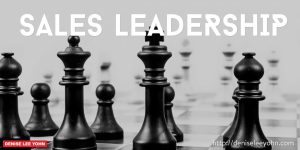How to Achieve Sales Leadership
In the research I did for my latest Harvard Business Review column, The Best Salespeople Do What the Best Brands Do, I came across a lot of terrific sources on how to achieve sales leadership. I was only able to include a few in the piece, so here’s a round-up of some more clarifying insights on sales leadership and how they tie to the brand-building principles that great salespeople execute:
In 10 Ways to Be Seen as a Sales Leader by Your Customers, Mark Hunter writes, “It’s not what you sell; it’s how you help the customer that makes the difference.” Among his list of “list of 10 things every salesperson needs to be doing if they want to be seen as a sales leader” is: “Ask the customer questions both you and the customer can’t answer as a way to spur critical thinking.”
- This is a great example of how “Great salespeople don’t imitate, they innovate,” which is based on the brand-building principle, “Great brands ignore trends.” In my HBR column, I explained that “Great brands don’t follow what everyone else is doing, nor do they wait to take their lead from customers. In the same way, great salespeople offer their customers unique perspectives and often seek to push their thinking. They present a differentiated sales experience by challenging customers’ status quo and teaching them something new and valuable.“
More on not following everyone else comes from a post, Why “Solution-Selling” (Problem-Solving) Is the WRONG Conversation to Have with CXO Buyers, on the CustomerThink blog by Jack Dean of Fast Partners. He writes, “Don’t follow the Solution-Selling herd. Break away. March to a different, more sophisticated, drum beat. Shift your mindset and change your customer conversation. Focus on one theme: impacting the customer’s business priorities and outcomes, not solving problems with your solution. Listen with the intent to understand, not the intent to respond. Stay alert and maintain high-levels of personal curiosity. Stop following your agenda and start following the customer’s agenda.”
Deb Calvert has an excellent infographic on her topic of Stop Selling & Start Leading. Deb’s research suggests that sellers are more successful when they replace “stereotypical sales behaviors” with leadership behaviors. One of her points labelled “What Sellers Can Do” is: “Differentiate yourself from other sellers by stepping into your role as a leader. Inspire buyers to come to you.”
- This resonated with me on the idea that “Great salespeople attract the best customers for their company” (and “Great brands don’t chase customers.”) “Just as great brands know they’re not for everybody,” I wrote, “and so they seek to attract loyal and profitable customers through shared values and common interests, great salespeople are selective when engaging prospects.”
In The Customer Doesn’t Care About Your Number!, David Brock covers the stress that many salespeople face about making their sales quotas. But he reminds us, “It’s not the customer’s job to help you make your numbers!” He goes on to say, “Strategies we develop to accelerate the sale to meet our needs detract from the value we create with our customers.” And he offers a different perspective: “If we can’t help the customer understand the compelling reasons to make a decision now, in terms meaningful to them, we will never get them to accelerate their decision making process.”
- This speaks to the principle, “Great salespeople create real value for their customers,” which is inspired by the brand-building principle, “Great brands never have to ‘give back.’” If you’re struggling to compel people to buy, then you’re probably not creating real value for them. In my HBR piece, I observed, “Great salespeople don’t engage with customers simply to make a sale — they look for ways to make their clients more successful.“
Finally, Jeb Blount addresses the final point in my piece about how the best salespeople are brand evangelists. In Do You Need to Love or Be Passionate About What You Sell to be Good at Selling It?, he explains how you can be a brand evangelist for products that are mundane or boring, or those that you just don’t love. “Not loving what I am selling is not the same as not believing in what I am selling,” he says. “There is a difference. I’ve always believed that what I was selling could help my prospect.”
That’s why brand evangelism — and sales leadership — is all about. The last line of my HBR article reads,
Brand evangelism is about engaging customers in a way that produces stronger and more valuable brands and sustaining long-term business success for their companies and their clients.
related: